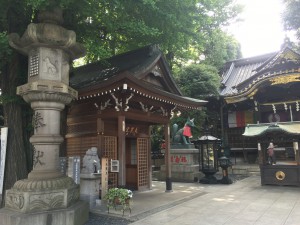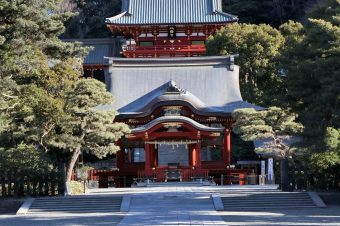 The Toyokawa Inari Temple is often debated about regarding whether it is actually a temple or if it is a shrine. This place of worship is definitely a temple, however it can be misleading as it contains several Shinto-related qualities. This temple is historically important due to the fact that, in the early Meiji Era, the government demanded that the temple separate itself from its Shinto qualities, yet the temple resisted. This helped contribute to the current outlook in Japan that the two religions can be practiced together.
The Toyokawa Inari Temple is often debated about regarding whether it is actually a temple or if it is a shrine. This place of worship is definitely a temple, however it can be misleading as it contains several Shinto-related qualities. This temple is historically important due to the fact that, in the early Meiji Era, the government demanded that the temple separate itself from its Shinto qualities, yet the temple resisted. This helped contribute to the current outlook in Japan that the two religions can be practiced together.
The Toyokawa Inari Temple is completely covered in fox statues. Fox statues are a huge image in the Shinto religion, and many Shinto shrines contain them. To make it even more confusing, the temple even has a large torii gate. Despite the Shinto references, the temple actually enshrines the deity, Daikini-Shinten. This deity is visualized as riding on the back of a large white fox.
 Beyond just the fox statues, the temple also features statues of the “Shichifuku pantheon.” The Shichifuku pantheon are the seven traditional deities of Japan. If you ask someone at the desk, you can purchase a long piece of paper that charts all seven of the deities. Then, you can go to each statue and get a stamp by each one on your paper.
Beyond just the fox statues, the temple also features statues of the “Shichifuku pantheon.” The Shichifuku pantheon are the seven traditional deities of Japan. If you ask someone at the desk, you can purchase a long piece of paper that charts all seven of the deities. Then, you can go to each statue and get a stamp by each one on your paper.
The main hall of the temple is allowed to be entered, but please remove your shoes first. The front of the main hall also has a gigantic gong that you can hit by using a gigantic rope. First, throw a coin into the offertory box. Then, bow once before hitting the gong. After that, you may pray, then bow once more.
 This temple sits in Akasaka, Tokyo, an area full of skyscrapers and government buildings. The temple is easy to find thanks to its thousands of tall flags and large red lanterns. This temple is truly beautiful and filled with small, intricate det
This temple sits in Akasaka, Tokyo, an area full of skyscrapers and government buildings. The temple is easy to find thanks to its thousands of tall flags and large red lanterns. This temple is truly beautiful and filled with small, intricate det ails such as fox carvings in stone and tight pathways. I would highly recommend this temple to anyone, seeing as you get the experience of a shrine and a temple in one location. Also, the fox statues are incredible to look at and really makes the temple unique. For travelers who are not in the Tokyo area, there are also branches of this temple in Osaka, Yokosuka, Fukuoka, and Sapporo.
ails such as fox carvings in stone and tight pathways. I would highly recommend this temple to anyone, seeing as you get the experience of a shrine and a temple in one location. Also, the fox statues are incredible to look at and really makes the temple unique. For travelers who are not in the Tokyo area, there are also branches of this temple in Osaka, Yokosuka, Fukuoka, and Sapporo.

| Name | Toyokawainari-Tokyo(temple) |
|---|---|
| Japanese name | 豊川稲荷東京別院 |
| Kami( ?) | |
| Address | 1-4-7,Motoakasaka,Minato-ku,Tokyo |
| Direction | The Ginza Line and The Marunouchi Line at Akasakamitsuke/ |
| Price | |
| Hours | |
| Event | |
| Goshuin(?) | |
| Website | http://www.toyokawainari-tokyo.jp/ |
| Other |
From Haneda Airport: Take the Keikyu-Kuko Line bound for Imbanihon-Idai from the Haneda Airport Internation Terminal. Stay on this vehicle for 21 minutes, then get off at Shimbashi Station. Get on the Ginza Line bound for Shibuya at Platform 1. Get off 5 minutes later (3 stops later) at Akasakamitsuke Station. Walk 7 minutes to the temple.
From Narita Airport: From the Airport Terminal 2 Station, take the Narita Skyaccess bound for Haneda Airport Domestic Terminal. Stay on this same vehicle for 66 minutes, then get off at Shimbashi Station. Get on the Ginza Line bound for Shibuya at Platform 1. Get off 5 minutes later (3 stops later) at Akasakamitsuke Station. Walk 7 minutes to the temple.





